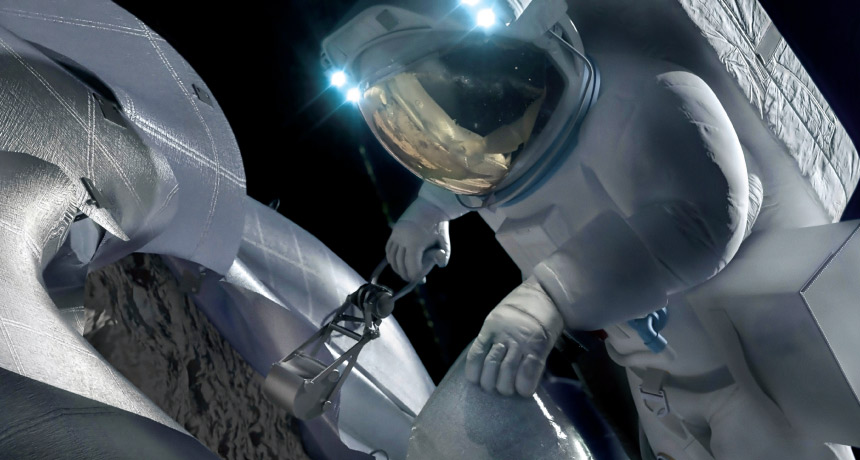Asteroids: A stepping stone to Mars?
NASA says snagging an asteroid can get us closer to the Red Planet, but many scientists disagree

If NASA's Asteroid Redirect Mission goes as planned, astronauts will visit an asteroid within the next decade.
NASA
People have long dreamed of visiting Mars. NASA, the U.S. space agency, now has a plan to help prepare astronauts for a trip to the Red Planet. That plan, however, starts with a wild idea that sounds like it came from a wacky Saturday morning cartoon: Capture an asteroid, then drag it to the moon.
NASA’s Asteroid Redirect Mission, or ARM, is designed to do just that. And it goes further: Once the asteroid is in place, a spacecraft would bring people to visit it. The agency says ARM will help scientists develop the technology needed to send people all the way to Mars. Indeed, the moon’s neighborhood is different than the near-Earth environment. In many ways, it’s more similar to the deep-space conditions that a Mars-bound spacecraft would encounter.
Asteroids are space rocks that orbit the sun. The largest, called Ceres (SEER-eez), is 1,000 kilometers (600 miles) across. It’s so big that it is classified as a dwarf planet. Most asteroids follow a path that takes them between Mars and Jupiter. Some pass close enough to Earth to make scientists — and everyone else — nervous about a collision. And for good reason: A giant asteroid impact could wipe out life on Earth.
NASA is considering two ways to grab a space rock. One calls for a spacecraft to deploy a giant, inflatable bag that would surround an asteroid. After jacketing the space rock, the bag would cinch shut like a kitchen trash bag. Then the spacecraft would slowly drag the big, bagged rock toward the moon.
The other plan may use a sticky-fingered robot to snatch a boulder off the surface of a much larger asteroid. A spacecraft would then ferry that rock to the moon. There it would wait for astronauts to explore it later. To date, NASA has not decided which asteroid it would like to hijack for study.
But if the mission were successful, “We would have access to a completely new alien body that no one had ever touched or seen,” Tom Jones told Science News. He’s a planetary scientist and former astronaut who has studied the ARM.
Some scientists, however, are skeptical. Moving an asteroid won’t get people any closer to Mars, they say.
“There’s nothing about pushing around a tiny space rock that has anything to do with getting humans to the moon or Mars,” Richard Binzel told Science News. A planetary scientist at the Massachusetts Institute of Technology in Cambridge, he studies near-Earth asteroids.
And Binzel isn’t the only critic. Others say the planned mission to an asteroid wouldn’t even deliver much in terms of new science.
“NASA’s just looking for a place to go,” Alan Harris told Science News. An asteroid scientist, he used to work at NASA’s Jet Propulsion Laboratory in Pasadena, Calif. He calls the mission “good entertainment.”
People have always been interested in space discoveries, and NASA says the ARM can play an important role in future explorations. Robert Lightfoot Jr. is NASA’s Associate Administrator. Getting to an asteroid can fuel the development of new technologies that could eventually land people on Mars, he told Science News.
Still, he knows everyone will not agree on the best way to get to Mars. “If there’s one thing I’ve learned in this industry, it’s that people are going to have different approaches,” he says. “The primary goal for us is to get humans to Mars. … To us, the Asteroid Redirect Mission is the most logical and affordable step.”
Power Words
asteroid A rocky object in orbit around the sun. Most orbit in a region that falls between the orbits of Mars and Jupiter. Astronomers refer to this region as the asteroid belt.
Ceres The largest known asteroid orbiting the sun, it sits 270 million kilometers (nearly 168 million miles) from Earth. It sits in the asteroid belt between Mars and Jupiter. At about 1,000 kilometers (600 miles) across, it so big that it is classified as a dwarf planet. It also hosts water. In 2014, astronomers found it spewing water from two places on its surface.
dwarf planet One of the solar system’s small celestial objects. Like a true planet, it orbits the sun. However, dwarf planets are too small to qualify as true planets. Prime examples of these objects: Pluto and Ceres.
Jupiter (in astronomy) The solar system’s largest planet, it has the shortest day length (10 hours). A gas giant, its low density indicates that this planet is composed of light elements, such as hydrogen and helium. This planet also releases more heat than it receives from the sun as gravity compresses its mass (and slowly shrinks the planet).
Mars The fourth planet from the sun, just one planet out from Earth. Like Earth, it has seasons and moisture. But its diameter is only about half as big as Earth’s.
moon The natural satellite of any planet.
NASA (National Aeronautics and Space Administration) Created in 1958, this U.S. agency has become a leader in space research and in stimulating public interest in space exploration. It was through NASA that the United States sent people into orbit and ultimately to the moon. It has also sent research craft to study planets and other celestial objects in our solar system.
orbit The curved path of a celestial object or spacecraft around a star, planet or moon. One complete circuit around a celestial body.
technology The application of scientific knowledge for practical purposes, especially in industry — or the devices, processes and systems that result from those efforts.







